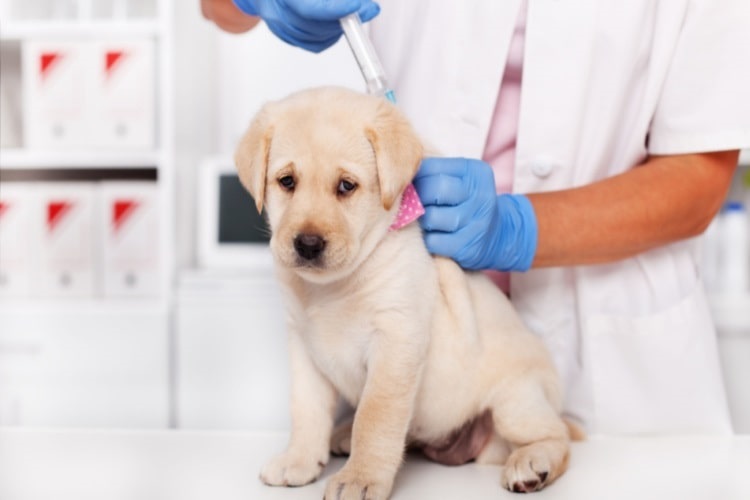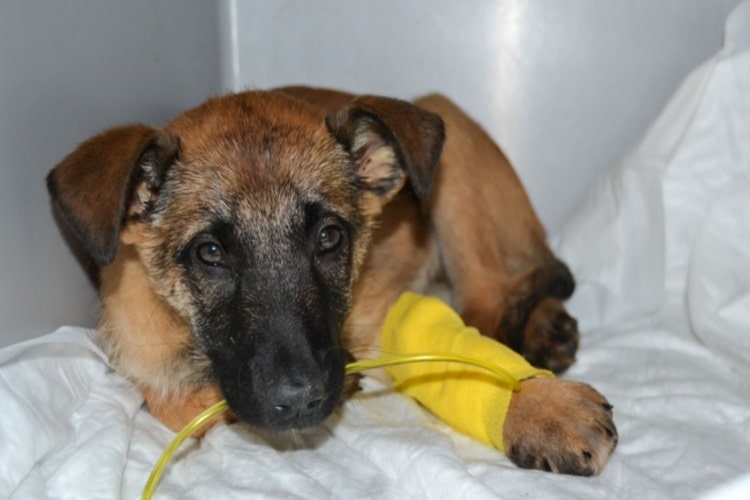Parvovirus is a highly contagious disease that can be deadly without treatment. Vaccines to protect your puppy are very safe and effective. Know how to protect your puppy from this fatal yet easily preventable disease. – Erica Tramuta-Drobnis, VMD, MPH, CPH
You just got a new puppy. Now what?
You want to provide your puppy with a healthy, happy home. But you’ve heard of the dreaded Parvovirus, aka “Parvo,” and aren’t sure what you should do next.
Regardless of where you got your new puppy, from a breeder or adoption center, or from the neighbor down the street, make sure you take your new dog to the veterinarian within 7-10 days. You want to ensure the pet is healthy and you have all you need for the puppy.
Often, young dogs less than 6 months of age are sold or adopted out “with shots.” This doesn’t mean they are fully vaccinated. Going to the veterinarian routinely and ensuring your pet has all necessary immunizations and preventative therapies such as flea, tick, and heartworm prevention will help ensure you provide your pup with the best care possible.
Parvovirus affects dogs of any age but most commonly the unvaccinated, puppies less than 6 months, and the immunocompromised. Keep reading to learn more about parvo disease, the clinical signs, diagnosis and treatment, prevention, and what to expect during recovery.
In This Article
What is the dreaded Parvovirus?
Parvovirus is a virus that attacks deep in the intestines of dogs and related species. Cats nor people can become sick with the virus. Still, it is easily transmitted from one dog to another and from contact with contaminated environmental surfaces. You could have even tracked it in on your shoes and not know it. Surfaces of kennels, dog food bowls, and toys can also be sources of infection. The virus can survive on a dog’s fur or feet and be carried to other animals.
Parvo attacks healthy intestinal cells and destroys the lining of the intestinal tract and some key blood cell elements (white blood cells). Rapidly dividing cells means fast cell turnover, making new cells to replace old ones. The virus attacks these rapidly dividing cells, especially those lining the GI tract and the bone marrow, damaging the immune system and the body’s means to protect itself in the face of damage or infection. The damage to the intestines and immune system sets off a cascade of damage to the body, ultimately leading to death if left untreated.
Why did my puppy get Parvo?

Your puppy was simply being a puppy. Puppies become infected by being around other dogs with the disease, investigating their environment, stepping in contaminated areas, sniffing around, and rubbing against something carried on someone’s shoes or clothing. Unfortunately, it is that easy to pick up the virus. Ultimately, the puppy swallowed viral particles to become infected (either sniffing them in or picking them up with its mouth). Puppies are naturally curious and investigate with their noses and mouths. Because the virus so easily spreads from animal to animal and from non-living things (e.g., shoes, bowls, or toys), they can easily become infected.
Additionally, parvovirus exists in the environment even if your dog had no exposure to other dogs. Other species, such as fox, can also transmit the disease.
Does my dog have Parvovirus?
Puppies get sick, and adult dogs get sick. However, unvaccinated dogs or dogs less than 1 year of age are most likely to acquire parvovirus and show illness. Some of the signs may be vague, like decreased appetite or energy. In any puppy or newly acquired pet, anything that departs from the normal, consider monitoring and having the pet evaluated.
Your veterinarian will generally test the puppy using a stool sample that tests for the virus (an ELISA snap test) and evaluate your dog’s white blood cell count. In puppies and non-vaccinated dogs, a negative test doesn’t rule out the disease. If the dog is not yet shedding enough virus particles to be detected (in the first few days after infection), the test may be negative. Sometimes testing more than one day in a row is necessary.
Could a test be falsely positive? Yes, but it is rare. Any dog with a positive test, clinical signs of parvovirus, a low white blood cell count, and incomplete vaccination status supports a diagnosis.
Vets use a combination of clinical signs, physical exam findings, fecal tests, and white blood cell counts (which can drop dramatically when the disease is present) to help diagnose this disease.
Clinical signs of Parvovirus in dogs
Parvovirus signs generally start 5 to 7 days after the dog becomes infected. However, signs can show up as few as 2 days after exposure to up to 2 weeks post-exposure.
All veterinarians and technicians know what a parvo dog looks (and smells like). They have the classic history of vomiting, decreased or no appetite, and horrifically bloody loose to liquid stools (diarrhea). A classic smell also pervades but really just represents the bloody stool and damaged GI tract.
Signs of parvovirus can include:
- Decrease or loss of appetite
- Belly pain
- Bloating
- Fever OR low temperature
- Lethargy (laziness, lack of playfulness, weakness, sleepiness)
- Depressed
- Vomiting
- Horrible diarrhea, often bloody
- Sadly, even death
The cascade of events happens very quickly. Dogs can rapidly become severely dehydrated and even go into shock due to the severe damage to the GI tract and the dog’s immune system. The virus attacks and then invades the small intestine and can quickly cause the white blood cells to drop, increasing the risk of secondary disease and is life-threatening.
Puppies can be fine, playing and acting like puppies one minute but can easily become gravely ill in just a few hours. Puppies, especially smaller breed dogs, need to eat every few hours when young, and missing a meal or two may be fine. Still, missing more than a few meals, puppies can have trouble regulating their blood sugars and deteriorate quickly.
Is there a cure for ‘Parvo’?
Sadly, there is no cure for this disease. Treatment involves supportive care. Some dogs may survive with outpatient therapy, but a large percentage require hospitalization, IV fluids, pain medication, antibiotics to prevent secondary infection, anti-nausea, anti-vomiting medications, and medications for diarrhea. Some dogs need nutrition support via syringe feeding or nasogastric tubes (a tube placed into the nose through to the stomach). The sooner the gut gets nutrients (aka food), the sooner it can heal itself.
Is there a vaccine for Parvovirus? How many shots are needed?

Thankfully, we have very successful vaccines that help protect your pet against parvovirus. The parvovirus vaccine is a core vaccine, meaning it really isn’t an option.
Vets usually give parvo as a combination vaccine that helps protect against parvovirus, distemper virus, adenovirus, and hepatitis virus. In conjunction with rabies vaccination, this combo vaccine makes up the core vaccines your puppy should regularly get throughout the pet’s life. Additional vaccines vary with where you live and with your dog’s lifestyle.
Puppies get their first shots at 6 weeks of age and then every 3 to 4 weeks after that until they are at least 16 weeks of age. Then 1 year later, they will receive a booster. After that point, vaccines are given every 1 to 3 years, depending on exposure risks and other factors.
Core vaccine recommendations exist because of how bad the diseases are, how common they are, and how easily they can be transmitted to others. The recommendations are based on overall risk and sound medical evidence.
While an understandable concern, vaccine reactions are rare, and the risks of getting the disease far outweigh the minimal chances of a vaccine reaction. Most vaccine reactions are not life-threatening and can be easily managed.
But does the vaccine work? My puppy still got Parvo
In the 1970s, when this disease first reared its ugly head, outbreaks were seen far and wide. Because of successful vaccination campaigns, disease occurrences are fewer and far between.
The parvo vaccine is safe and effective. But the timing of the vaccine is critical to ensuring immunity. We vaccinate puppies from 6 to 16 weeks with multiple doses because the pup’s mom provides antibodies through her milk that wane over time. When these protective antibodies from mom disappear varies from puppy to puppy. Thus, several doses spaced 3 to 4 weeks apart are critical to ensure the immune system can mount a complete response.
Dogs that are “vaccinated” but get sick from parvovirus within a week to 10 days of vaccination were already incubating the virus pre-vaccination. It isn’t that the vaccine gave them parvo! The virus incubates and takes time after exposure until a dog starts showing signs of disease.
Can puppies get Parvovirus more than once?
While parvovirus can be deadly, a pet who survives a parvovirus infection is thought to develop lifelong immunity to the disease. Even if there were to be a rare occasion where this wasn’t the case, the core combination vaccine we administer to dogs includes the parvo component. So, even dogs who had parvo as puppies, their immune system still gets a boost when they get their combo vaccine.
Will my puppy survive Parvo?
Will your puppy survive parvo to tell his friends? The answer to this question partly depends on you. Factors impacting survival include:
- How quickly do you recognize your pup is sick and seek care
- Your ability to afford care
- Your pet’s age and vaccine status
- Genetics
Treatment options for canine Parvovirus
Again, there’s no magic treatment, and the disease has to run its course. For some dogs less affected, they may be able to be managed at home with medications by mouth and a special diet. But many dogs need hospitalization and intensive care.
Unfortunately, the reality is that parvo treatment is costly. When hospitalized, the cost of treatment can become a limiting factor for many pet parents. Hospitalized patients need 24-hour care; many may be hospitalized for 5 to 7 days. Always have a rainy day fund for your pet for emergencies.
Survival rates
Recognizing that your puppy is sick early and promptly bringing them to a veterinarian increases your pet’s chance of survival.
Puppies not showing any improvement with intensive 24-hour care by day three or four have a poor prognosis. Though veterinary professionals are unsure why, some breeds have higher death rates than others, including the Rottweiler, English Springer Spaniel, and Doberman Pinchers.
With appropriate medical care, survival can be up to 90%. Without treatment, that percentage greatly falls and can be near 100% who die from the disease.
I have another dog at home. Will it get sick from Parvo?
Fully vaccinated dogs, even those already exposed to the pet sick with parvo, are unlikely to have an issue. If you have an older dog who has had vaccines in the past but is not up-to-date on the vaccine, get that dog evaluated and boost the vaccine asap.
I want to bring another dog home. How long should I wait?
This can be a difficult question because parvo survives inside for several months and outdoors for months to years. It likes really dark and moist environments best. Additionally, the type of virus it is, a non-enveloped virus, is not easy to destroy with common disinfectants or soaps.
Even if you wait 6-12 months before getting another dog and disinfect all surfaces with appropriate products, you can never truly eliminate the virus from your home once it is there. The same goes for the outside environment.
How to prevent Parvovirus
Prevention remains key. This includes ensuring your puppy gets all the proper vaccines at the correct time interval and gets boosters throughout life to maintain immunity.
Additionally, we do not recommend that any dog (regardless of age) be taken to pet stores, dog parks, or walked in wooded areas or trails until 100% fully vaccinated. For puppies, once your dog gets that last vaccine at 16 weeks, we consider them vaccinated. However, we can still see the disease in older dogs and those with weakened immune systems. So, it isn’t until after that 1-year booster vaccine that we consider them truly vaccinated. It is up to you how much exposure you want to risk with your pup during that first year of life.
A good rule of thumb, though, is any new dog with a previously unknown vaccine history and puppies less than 4-5 months of age should be kept away from dog parks, grooming, boarding, daycare, and similar areas, as well as pet stores until your vet says they are fully vaccinated.
How to disinfect
For detailed information on how to disinfect your home and outside environment after your pet has had parvovirus, see this information from Veterinary Partner. Note that bleach is one of the most effective means to remove contamination but use caution with bleach and prevent accidental exposure to your pets.
Remove any obviously contaminated clothing, bedding, non-cleanable toys, dishes, or similar materials. Surfaces that can be disinfected should be using protocols and products described in the Veterinary Partner link.
Attempt to remove any contaminated materials outside and inside but recognize that you will never fully make the area safe.
We recommend, ideally, that no unvaccinated dog be exposed to your home or outside property for 6 to 12 months, even after you have cleaned and disinfected.
Parvovirus recovery: what to expect as your pet recovers from parvo
Energy level
Don’t expect your puppy to come home from the hospital and be balls of energy immediately. They still have some healing to do and may still have an abnormal stool; this takes time to normalize. They will still be recovering and may be on medications and a prescription bland diet.
Feeding
Ensure you feed the prescribed food. It may be a homecooked meal, or it may be a prescription bland diet. But either way, feed as directed. No table scraps, treats, or new foods. If your dog is one that enjoys getting into the trash, consider getting a dog proof trash can to prevent him from accessing any scraps on his own.
Small frequent meals are key. This allows the GI tract to heal but also never be fully empty, so the gut doesn’t have to work too hard at one time.
Do not suddenly switch to the original dog food. Once your pet’s stool has been normal for 3-4 days, you can slowly (over another 3-5 days) transition the dog from the bland diet to the regular dog food.
Never abruptly switch foods in any dog, or you risk causing GI upset.
Exercise restrictions
Dogs with parvovirus can still shed the virus even once they have outwardly recovered and are back to eating and drinking normally and have formed stool. Dogs are considered contagious for up to a month after the infection starts. So keep this in mind. No public places for a month, no dog parks, daycare, or other related areas, and leash walk only on your own property. Always pick up poop immediately after they go to prevent further environmental contamination.
Your pup survived Parvo. Now what?
So what should you expect post parvo infection? The course of parvo generally lasts 1-2 weeks. But the good news is that usually, there are no residual issues, and dogs who survive the disease can live happy healthy lives.
But remember, preventing the disease before it happens is much easier than treating it. Just make sure your dog gets vaccines throughout their lives to make sure they remain protected!
The material from this article came from the expertise of the author and the following resources.12345678
Article Sources
Pets Digest uses only high-quality sources, including peer-reviewed studies, to support the facts within our articles. Read our editorial process to learn more about how we fact-check and keep our content accurate, reliable, and trustworthy.
- The American Veterinary Medical Association (AVMA). Canine parvovirus. American Veterinary Medical Association. Published 2022. Accessed June 21, 2022. https://www.avma.org/resources-tools/pet-owners/petcare/canine-parvovirus
- Cornell University’s Baker Institute for Animal Health. Canine Parvovirus. Cornell University College of Veterinary Medicine. Published December 5, 2017. Accessed June 21, 2022. https://www.vet.cornell.edu/departments-centers-and-institutes/baker-institute/our-research/canine-parvovirus
- Day MJ, Horzinek MC, Schultz RD, Squires RA. WSAVA Guidelines for the vaccination of dogs and cats: WSAVA Vaccination Guidelines. J Small Anim Pract. 2016;57(1):E1-E45. doi:10.1111/jsap.2_12431
- Tramuta-Drobnis EL. Dog Vaccinations: What you need to know. Mini Schnauzer Planet. Published January 22, 2022. https://minischnauzerplanet.com/dog-vaccinations-what-you-need-to-know/
- Howell H. Sanitizing and Disinfecting the Environment after Parvovirus in Dogs. Veterinary Partner – VIN. Published May 20, 2021. https://veterinarypartner.vin.com/default.aspx?pid=19239&id=10259151
- Brooks W. Parvovirus: Caring for the Recovered Dog. Veterinary Partner – VIN. Published May 5, 2021. https://veterinarypartner.vin.com/default.aspx?pid=19239&id=4951465
- Gallagher A. Canine Parvovirus – Digestive System. Merck Veterinary Manual. Published 2020. Accessed June 21, 2022. https://www.merckvetmanual.com/digestive-system/diseases-of-the-stomach-and-intestines-in-small-animals/canine-parvovirus
- Ward E, Panning A. Parvovirus in Dogs. VCA Animal Hospitals. Accessed June 21, 2022. https://vcahospitals.com/know-your-pet/parvovirus-in-dogs


